

Refreezing the Arctic. Living below Nepal’s melting mountains. Weather warning for climate meeting. The nearly 300 climate scientists from 60 countries attending the big IPCC conference in Kathmandu this week are aware that each of them will have emitted between 6-10 tons of carbon flying to and from Nepal.
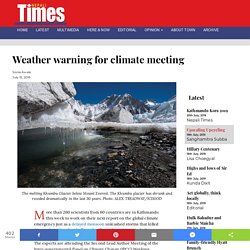
Civil aviation contributes more than 3% of the carbon emissions that is warming the atmosphere. Ironically, this year’s freak monsoon was partly caused by climate change, and forced many of the flights that scientists were taking to Kathmandu this week to hold for hours in the air, or to be diverted, further increasing their carbon footprint. Many in social media are asking if flying 300 scientists across the planet to write voluminous reports that governments ignore is worth the carbon it generates. Why can’t they just Skype? Mount Everest: Melting glaciers expose dead bodies. Image copyright Frank Bienewald. A third of Himalayan ice cap doomed, finds report.
At least a third of the huge ice fields in Asia’s towering mountain chain are doomed to melt due to climate change, according to a landmark report, with serious consequences for almost 2 billion people.
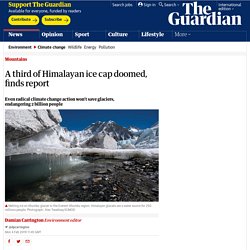
Even if carbon emissions are dramatically and rapidly cut and succeed in limiting global warming to 1.5C, 36% of the glaciers along in the Hindu Kush and Himalaya range will have gone by 2100. If emissions are not cut, the loss soars to two-thirds, the report found. The glaciers are a critical water store for the 250 million people who live in the Hindu Kush-Himalaya (HKH) region, and 1.65 billion people rely on the great rivers that flow from the peaks into India, Pakistan, China and other nations. Terrifying assessment of a Himalayan melting. While the global media’s attention is on the Greenland ice sheet, the Arctic and eastern Antarctica, a landmark report released this week shows that the Himalaya will face catastrophic meltdown during this century if there is no immediate effort to reduce the world’s carbon emissions.

The voluminous 627-page report titled Hindu Kush Himalaya Assessment: Climate Change, Sustainability and People put together by the International Centre for Integrated Mountain Development (ICIMOD) states that even in the best-case scenario, the Himalayan mountains will lose more than one-third of their ice by the end of the century. An earlier report was even scarier, it said the Mt Everest region would lose 90% of its ice by 2100. Read also: Climate climax, Editorial The great Himalayan thaw, Ajaya Dixit But that would happen only if global average temperatures can be capped at a 1.5oC increase above pre-industrial levels. Climate change threatens 1,000-year-old monastery in remote Nepal.
Humla District, Nepal - The trans-Himalayan village of Halji is a small collection of about 80 closely packed mud-and-stone houses at the base of a moraine hill.
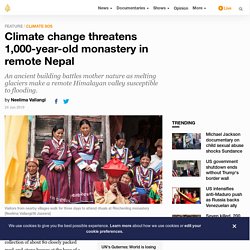
Steep cliffs rise on either side of the village that is flanked by a glacial stream on its left. By contemporary standards, Halji is extremely remote. It is snowed in and cut off for six months of the year during winter and does not have mobile network connectivity. The district headquarters, Simikot, is a five-day walk away. And getting to Kathmandu involves an expensive flight from Simikot. Greenland's ice melting faster than scientists previously thought – study. Greenland is melting faster than scientists previously thought, with the pace of ice loss increasing four-fold since 2003, new research has found.

Enormous glaciers in Greenland are depositing ever larger chunks of ice into the Atlantic ocean, where it melts. On thin ice in the Khumbu. The Khumbu Icefall funnels ice from the Western Cwm below Everest, Lhotse and Nuptse to the glacier below.

The ice here has receded at an average of 30m/y in the past 20 years, but it has also shrunk vertically, losing up to 50m in thickness. Everest Base Camp was at 5,330m when Hillary and Tenzing climbed Mt Everest in 1953, today it is at 5,270m. The bottom of the ocean has started sinking under the weight of melting glaciers. Russian tanker sails through Arctic without icebreaker for first time. Russian tanker passes through Arctic Ocean from Norway to South Korea without an icebreaker for the first time. Svalbard Global Seed Vault Floods as Permafrost Melts. This story originally appeared on the Guardian and is part of the Climate Desk collaboration.
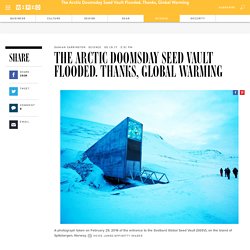
It was designed as an impregnable deep-freeze to protect the world’s most precious seeds from any global disaster and ensure humanity’s food supply forever. Arctic stronghold of world’s seeds flooded after permafrost melts. It was designed as an impregnable deep-freeze to protect the world’s most precious seeds from any global disaster and ensure humanity’s food supply forever.

But the Global Seed Vault, buried in a mountain deep inside the Arctic circle, has been breached after global warming produced extraordinary temperatures over the winter, sending meltwater gushing into the entrance tunnel. The vault is on the Norwegian island of Spitsbergen and contains almost a million packets of seeds, each a variety of an important food crop. Earth - There are diseases hidden in ice, and they are waking up. Throughout history, humans have existed side-by-side with bacteria and viruses.
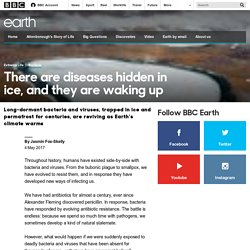
From the bubonic plague to smallpox, we have evolved to resist them, and in response they have developed new ways of infecting us. We have had antibiotics for almost a century, ever since Alexander Fleming discovered penicillin. In response, bacteria have responded by evolving antibiotic resistance. The battle is endless: because we spend so much time with pathogens, we sometimes develop a kind of natural stalemate. However, what would happen if we were suddenly exposed to deadly bacteria and viruses that have been absent for thousands of years, or that we have never met before?
We may be about to find out. Arctic melting feeds on itself - Climate News NetworkClimate News Network. Melting sea ice is affecting the closely-linked Arctic climate in a feedback that will speed up warming there, scientists say.
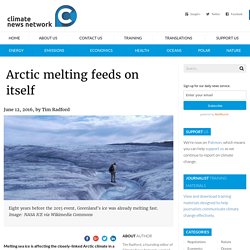
LONDON, 12 June, 2016 – Scientists have established at least one factor in the record melting of northern Greenland in 2015. The Arctic itself played a hand in what happened. In a process that engineers call positive feedback, high atmospheric pressure and clear skies over the Arctic region practically committed the northwest of Greenland to an episode of melting at record rates. And because the Arctic is the fastest-warming region on Earth, and because atmosphere and ocean influence each other, the steady loss of sea ice each year has forced a change in wind patterns.
This in turn has played back into the climatic machinery, according to a new study in Nature Communications. "Mountain people paying price for climate change" Director David Molden of ICIMOD spoke to Nepali Times after a recent visit to the centre's climate research station in Langtang. Jitendra Bajracharya / ICIMOD Director David Molden of ICIMOD (pictured, above) spoke to Nepali Times after a recent visit to the centre's climate research station in Langtang.
Catastrophic Sea Level Rise: More and sooner. What is not new Ultimately sea levels will rise several feet, given the present levels of CO2 in the atmosphere. We already knew this by examining paleo data, and finding periods in the past with similar surface temperatures and/or similar atmospheric CO2 levels as today. I put a graphic from a paper by Gavin Foster and Eelco Rohling at the top of the post. It does a good job of summarizing the paleo data.
If we keep pumping CO2 into the atmosphere at current, or even somewhat reduced, levels for a few more decades, the ultimate increase in sea levels will be significant. Let me rephrase that to make it clear. A conservative estimate is that likely sea levels will rise 8 meters or more, quite possibly considerably more. A new paper that is making a great deal of news, and that is still in peer review, suggests that the time frame may be shorter than man have suggested. What is not known We don’t really how long this will take. What is new See also this by Joe Romm. Sea_level_study_james_hansen_issues_dire_climate_warning. Photo by Joe Raedle/Getty Images In what may prove to be a turning point for political action on climate change, a breathtaking new study casts extreme doubt about the near-term stability of global sea levels.
The study—written by James Hansen, NASA’s former lead climate scientist, and 16 co-authors, many of whom are considered among the top in their fields—concludes that glaciers in Greenland and Antarctica will melt 10 times faster than previous consensus estimates, resulting in sea level rise of at least 10 feet in as little as 50 years. Why Greenland’s Melting Could Be the Biggest Climate Disaster of All. Posted by Chris Mooney on Monday, January 28, 2013. Arctic Temperatures Highest in 44,000 Years. Antarctic Rate of Ice Loss Double Previous Estimate. Climate Change: Vital Signs of the Planet: 2015 Arctic sea ice maximum annual extent is lowest on record. Major Antarctic ice survey reveals dramatic melting - environment - 26 March 2015. It's melting from above and below and crumbling at the edges.